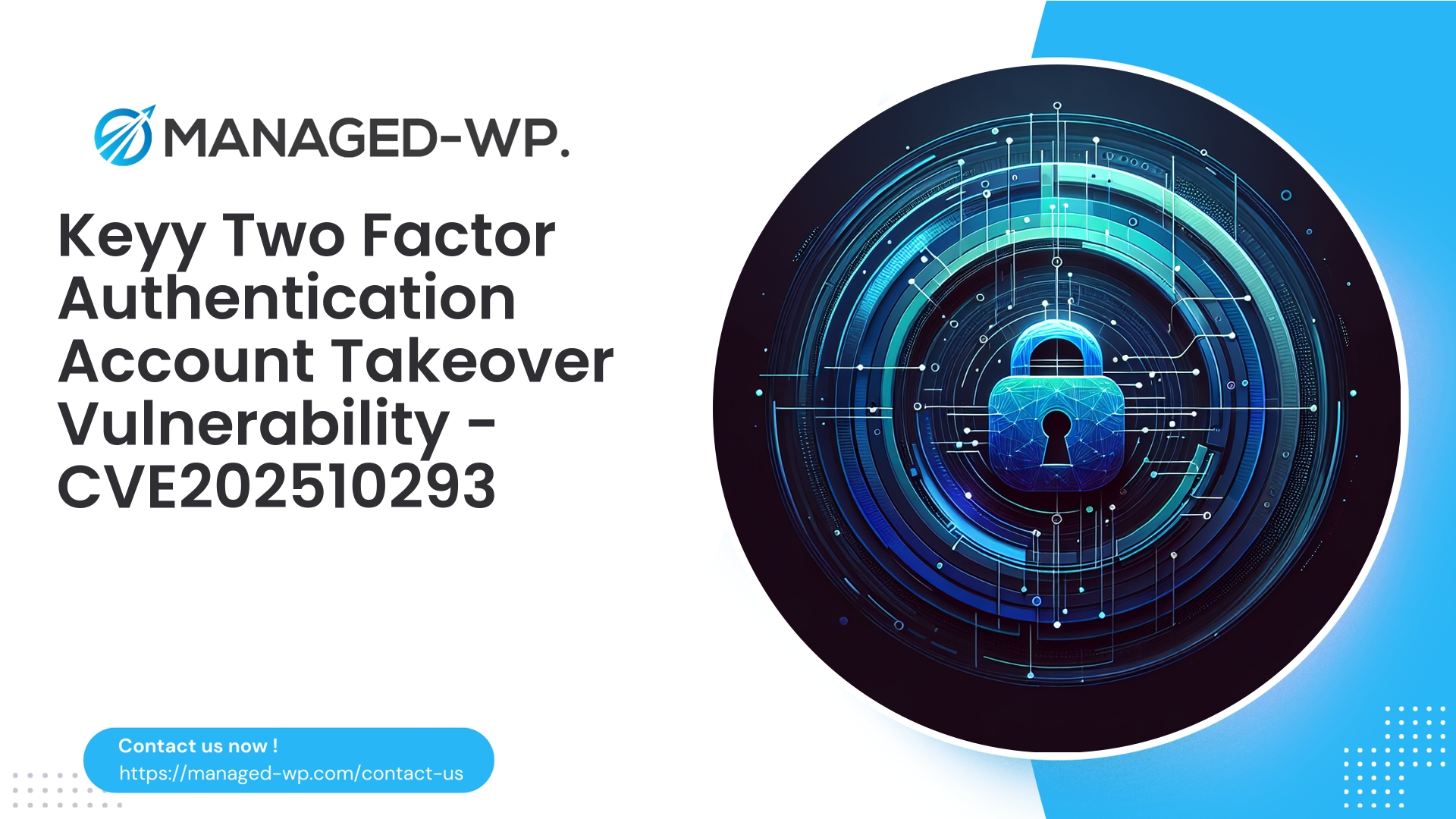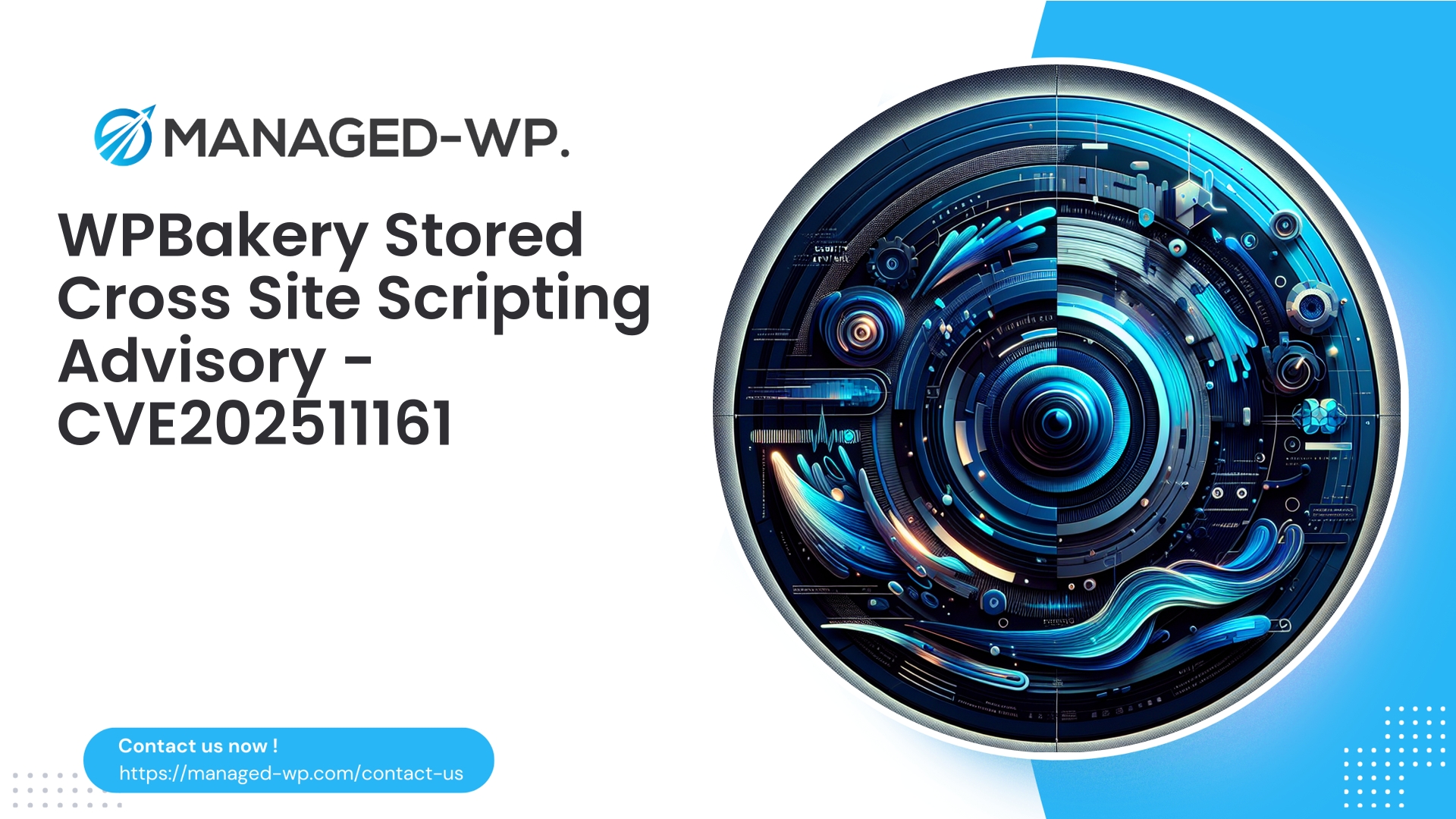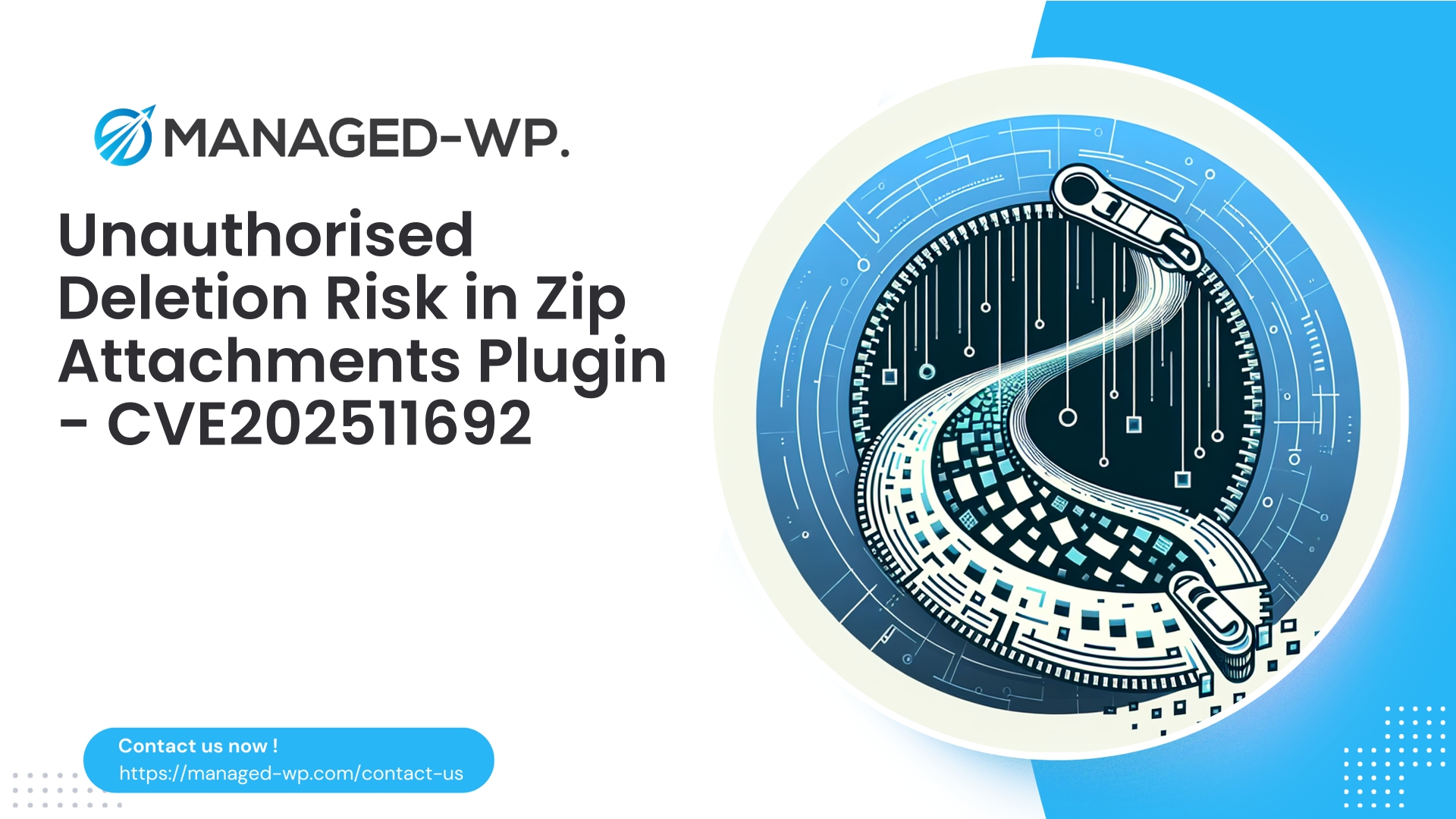| 插件名称 | Keyy 双因素认证(类似 Clef) |
|---|---|
| 漏洞类型 | 权限提升 |
| CVE编号 | CVE-2025-10293 |
| 紧急 | 高的 |
| CVE 发布日期 | 2025-10-15 |
| 源网址 | CVE-2025-10293 |
CVE-2025-10293 (Keyy ≤ 1.2.3) — WordPress 网站所有者的重要指南
针对 Keyy 双因素身份验证插件的权限提升漏洞 (CVE-2025-10293) 进行深入分析、风险评估和可行的缓解策略。由 Managed-WP 安全团队提供专家建议。
作者:Managed-WP 安全专家
日期:2025年10月16日
标签:WordPress、漏洞、CVE-2025-10293、安全、WAF、事件响应
概要: Keyy 双因素身份验证插件(类似 Clef)中发现了一个严重的权限提升漏洞 (CVE-2025-10293),影响版本最高至 1.2.3。拥有已认证的订阅者级别访问权限的攻击者可以利用此漏洞提升权限,甚至可能获得完全的管理员控制权限。目前尚未发布官方补丁。本综合安全公告涵盖了风险、检测方法、即时应对措施以及专为 WordPress 网站管理员量身定制的长期修复方案。
目录
- 执行摘要
- 已报告漏洞概述
- 为什么这种威胁对 WordPress 环境至关重要
- 技术分析:根本原因
- 哪些人风险最大?
- 48小时内必须采取的紧急措施
- Managed-WP 推荐的 WAF 和虚拟补丁策略
- 检测:标志和日志指标
- 综合事件响应和恢复检查清单
- 长期加固和安全最佳实践
- Managed-WP 如何为您提供支持
- 附录:常用的 WP-CLI 命令和检查
- 参考
执行摘要
2025年10月15日,Keyy双因素身份验证插件(≤1.2.3版本)中一个高危权限提升漏洞(CVE-2025-10293)被公开披露。该漏洞允许任何拥有订阅者权限的已认证用户利用账户接管漏洞,提升其访问权限,包括管理员权限。该漏洞的CVSS评分为8.8,构成严重的安全风险,尤其是在许多类型的WordPress设置中,例如会员平台、电子商务商店和社区论坛,都普遍存在订阅者账户。
无论您目前是否使用 Keyy 插件,本指南都值得您仔细阅读。下文概述的概念和缓解措施普遍适用于任何存在类似权限或所有权验证缺陷的插件。
对于 WordPress 管理员来说,这事关重大:此类漏洞一旦公开披露,针对它们的自动化攻击往往很快就会出现。降低风险最快的方法是利用托管防护(例如通过带有虚拟补丁功能的 Web 应用防火墙),停用存在漏洞的插件,审核并重置用户凭据,以及进行彻底的完整性扫描。
已报告漏洞概述
- 通过帐户接管路径触发的权限提升漏洞会影响 Keyy 双因素身份验证插件的所有版本,包括 1.2.3 版本。
- 利用此漏洞只需要一个经过身份验证的订阅用户级别帐户。
- 根本原因:插件内账户链接和管理过程中授权和所有权检查不足。
- 在发布此公告时,还没有官方补丁可用,因此网站所有者有责任立即采取补救措施。
发现者:Jonas Benjamin Friedli(公开报告日期:2025年10月15日)。官方CVE编号: CVE-2025-10293.
为什么这种威胁对 WordPress 环境至关重要
- 在允许注册的 WordPress 网站上,订阅者级别的帐户非常普遍,例如论坛、教育平台和电子商务商店。
- 权限提升至管理员级别后,即可完全控制网站,包括代码执行、数据库操作和持久安装后门。
- 由于没有官方补丁,情况更加紧迫;在厂商发布修复程序之前,短期虚拟补丁和操作缓解措施至关重要。
- 一旦信息泄露,利用行为往往会激增;拖延行动会大大增加被利用的风险。
技术分析:根本原因
我们不会公布漏洞利用代码,但其根本问题包括:
- 授权不足与身份验证不足:
— 该插件错误地假定已认证的请求会授予执行敏感操作(例如,用户属性更改或帐户关联)的权限。正确的实现需要严格的权限检查来验证用户权限。 - 所有权验证薄弱:
— 攻击者可以操纵账户关联令牌或用户标识符而无需验证即可劫持或合并账户。 - 不安全的 API/端点和客户端信任:
— REST 和 AJAX 端点可能缺乏 nonce 验证、输入清理和权限强制执行,从而打开攻击途径。 - 日志记录和监控不完善:
— 事件日志记录不足会延迟对攻击企图的检测和响应。
给开发者的建议: 强制执行严格的授权检查(例如,current_user_can()),严格验证所有权,对状态更改操作实施 CSRF/nonce,并维护全面的日志记录。
哪些人风险最大?
- 已安装 Keyy 插件的网站。
- 会员网站、学习管理系统 (LMS)、论坛和 WooCommerce 网站(存在订阅者帐户)。
- 之前安装过 Keyy 的网站——残留的配置或数据可能仍然可被利用。
典型的剥削手法:
- 注册或使用现有订阅账户。
- 通过与易受攻击的插件端点交互来劫持高权限会话或静默生成管理员帐户。
- 提升权限至管理员,然后安装后门,窃取数据,并将该网站用作攻击平台。
48小时内必须采取的紧急措施
对于插件版本受影响(≤1.2.3)的网站运营者,请优先执行以下步骤:
- 启用维护模式,限制调查期间的登录活动。
- 立即停用或移除 Keyy 插件:
– 如果您拥有受信任的管理员权限,则可通过 WordPress 管理后台的插件页面进行安装。
或者通过 SSH/SFTP 重命名插件目录:wp-content/plugins/keyy → wp-content/plugins/keyy.disabled.
或者运行 WP-CLI 命令:wp plugin deactivate keyy. - 如果无法停用插件(例如,网站被入侵),则在服务器或防火墙级别阻止对公共网站的访问。
- 强制所有管理员和特权用户重置密码;建议使用强密码和唯一密码。
– 轮换与网站用户相关的 API 密钥或集成密钥。 - 审核用户帐户是否存在意外的管理员角色或可疑的修改:
– WP-CLI 示例:wp user list --role=administrator. - 运行全面的恶意软件和文件完整性扫描,查找异常情况、修改过的核心文件或可疑脚本。
- 查看服务器和应用程序日志,以查找异常请求或活动(参见“检测”部分)。
- 如果您使用外部安全/CDN 服务,请暂时启用严格的站点级保护。
- 通过 WAF 实施托管虚拟补丁,以阻止针对 Keyy 插件端点的攻击尝试。
- 如果怀疑存在安全漏洞,请立即通知托管服务提供商和相关利益方。
如果没有托管的 WAF 或保护服务,请立即禁用该插件并按照上述步骤 4-8 进行操作。
Managed-WP 推荐的 WAF 和虚拟补丁策略
Managed-WP 提倡多层防御,首先立即进行虚拟修补以阻止漏洞利用请求,短期禁用易受攻击的插件,并在供应商发布修复程序后进行长期修补。
推荐的WAF规则包括:
- 阻止对 Keyy 插件特定端点的访问:
– 拒绝向处理帐户链接的插件 AJAX 或 REST 路由发送 HTTP 请求,除非来自已知的受信任 IP 地址。
– 防止未经授权的 POST 请求修改用户绑定。 - 阻止可疑的参数篡改:
– 检测并拒绝非管理员用户对用户 ID 或管理员绑定的更改。 - 阻止低级别帐户发出权限提升请求:
– 检查角色变更和新用户创建请求;如果来自未经授权的用户,则阻止并发出警报。 - 对状态变更端点强制执行 CSRF/nonce 规则:
– 拒绝缺少有效 WordPress nonce 令牌的 POST 请求。 - 限制账户管理端点的访问速率:
– 限制来自单个会话或 IP 的快速、重复请求。 - 监控异常管理员登录:
– 标记来自新位置或 IP 地址范围的访问,以便进行审核。 - 阻止已知的恶意用户代理和内容类型不匹配:
识别并拒绝可疑的自动化或格式错误的请求。 - 虚拟补丁规则:
– 静默地丢弃或阻止与易受攻击模式匹配的 HTTP 请求(例如,返回 403 而不透露详细信息)。
请注意: 规则的实施应谨慎,避免干扰网站的正常功能。在正式部署之前,务必在测试环境中进行验证。Managed-WP 可以协助进行规则调整和监控,以减少误报。
检测:标志和日志指标
早期发现至关重要。请查看日志和监控系统中的以下指标:
- 意外创建了新的管理员用户。
- 未经批准,角色从订阅者变更为管理员或编辑者。
- 来自未知 IP 地址的针对管理员帐户的密码重置请求。
- 向 Keyy 插件端点(AJAX、REST API)发出可疑的 POST 请求。
- 管理员邮箱、网站设置或插件配置发生意外更改。
- 短暂的管理员会话或来自多个 IP 的并发会话。
- 上传文件夹或核心文件夹中新增或修改的 PHP 文件。
- 未知的计划任务或异常选项值。
建议的日志查询和指标:
- 在信息泄露期间,搜索 Web 服务器访问日志中与插件相关的 URL 的 POST 请求。
- 插件操作后,检查 PHP-FPM/fastcgi 日志中是否存在错误或警告。
- 审核 WordPress 登录和用户活动日志(如果已启用),筛选用户创建、更新和角色分配。
可用于协助调查的 WP-CLI 命令示例:
- 列出所有用户及其角色:
wp 用户列表 --format=table - 查找 2025 年 9 月 16 日之后创建的订阅者:
wp user list --role=subscriber --field=ID,display_name,user_registered | awk '$3 >= "2025-09-16" {print}' - 获取管理员用户:
wp user list --role=administrator --fields=ID,user_login,user_email,user_registered --format=csv
建议同时进行文件完整性检查:
将插件、主题和核心文件的哈希值与干净版本进行比较,或者使用版本控制/git diff 来检测未经授权的修改。
如果检测到可疑活动,请立即按照以下事件响应清单进行操作。
综合事件响应和恢复检查清单
此分步计划可帮助您管理已确认或疑似通过此漏洞造成的入侵。您可以根据组织政策和监管要求对计划进行必要的调整。
- 遏制:
– 限制站点暴露(维护模式或网络级封锁)。
– 停用或重命名存在漏洞的插件文件夹。
– 撤销活跃会话;尽可能使用批量会话失效工具/插件或服务器缓存清除。 - 证据收集:
– 保留所有相关日志以备取证分析。
- 对文件和数据库进行全面的离线备份。
– 通过 WP-CLI 导出已安装的插件和主题清单。 - 根除:
– 经过详细审查后,删除未经授权的管理员帐户并撤销意外的角色更改。
– 将疑似被篡改的文件替换为经过验证的干净副本。
– 对可疑文件进行深度恶意软件扫描和人工审查。
– 重置密码并轮换所有相关密钥(SFTP、数据库、API 密钥)。 - 恢复:
– 如果有已验证的干净备份,请从备份中恢复。
逐步恢复服务并密切监控。
– 重新应用强化控制和WAF规则。 - 事件后行动:
– 再次轮换所有凭证和加密密钥。
– 一旦补丁发布,请更新插件、主题和 WordPress 核心。
– 开展全面的内部报告和经验总结会议。
– 如适用,请遵守法律通知要求。 - 长期验证:
– 安排在事故发生后至少 90 天内进行定期扫描和审核。
– 对用户和角色变更以及新插件安装实施持续监控和警报。
如果您不确定如何操作,请立即联系经验丰富的事件响应专家。Managed-WP 可提供专家支持和补救服务。
长期加固和安全最佳实践
为最大限度降低未来类似漏洞带来的风险,请实施以下措施:
- 最小特权原则:
– 只为用户分配他们需要的角色和权限。避免分配不必要的编辑或管理员角色。
– 对于集成帐户,隔离权限并定期轮换凭据。 - 限制插件安装和更新:
– 将安装插件的权限限制在少数受信任的管理员组内。
– 在生产环境部署之前,先在测试环境中测试更新。 - 用户和角色审核:
– 定期审核用户角色,并删除不活跃或过期的帐户。
– 对管理员和敏感帐户强制执行双因素身份验证,但不要依赖单个插件来实现 2FA。 - 安全的管理端点:
– 考虑在可行的情况下移动管理员登录页面并限制 IP 访问。
– 对 wp-login.php 和其他敏感端点实施速率限制。 - 应用程序安全性和代码质量:
– 选择维护活跃、更新历史记录清晰、并已发布安全披露信息的插件。
尽量减少插件数量,以减少攻击面。 - 全面日志记录和监控:
启用用户活动审计功能。
– 将日志与集中式 SIEM 或警报工具集成。 - 强大的备份和恢复流程:
– 定期进行备份并验证恢复能力。
– 保留安全的离线副本。 - 利用Web应用程序防火墙和虚拟补丁:
– 使用托管 WAF 在等待厂商补丁的同时,提供针对新兴威胁的即时保护。
Managed-WP 如何为您提供支持
Managed-WP 提供以多层防御为核心的 WordPress 安全解决方案,包括托管防火墙、网站定制的 WAF 规则、恶意软件检测和专家级缓解措施。以下是我们如何帮助您的网站抵御 CVE-2025-10293 等漏洞:
- 具有虚拟补丁功能的托管 WAF:
快速部署规则,阻止针对易受攻击插件路径的攻击尝试。
– 自定义检测并阻止低权限用户的提权尝试。 - 恶意软件扫描和清理:
– 扫描后门、文件修改和可疑文件。
– 高级套餐提供自动清理功能。 - 审计日志记录和实时警报:
– 持续跟踪用户角色变更、登录尝试和管理操作。
- 对可疑行为立即发出警报。 - 速率限制和暴力破解保护:
– 保护 wp-login.php 和 REST API 端点免受自动化滥用。 - 专家事件响应指南:
– 有安全专业人员可协助进行遏制、补救和恢复工作。
如果您尚未受到保护,请先使用 Managed-WP 的免费计划,以获得基础安全保障,同时评估更高级的保护方案。
立即开始使用 Managed-WP 的免费安全计划(无任何义务)
基本免费计划提供以下基本保障:
- 管理防火墙和虚拟补丁规则,以阻止已知的漏洞利用类型
- 无限带宽,以在正常流量下保持性能
- 内置恶意软件扫描器,可识别可疑文件和更改
- 涵盖 OWASP 前 10 大风险类别
立即激活您的免费保障:
https://my.wp-firewall.com/buy/wp-firewall-free-plan/
对于更深层次的安全控制,例如手动 IP 阻止和自动恶意软件清理,随着您需求的演变,请考虑 Managed-WP 的标准版或专业版计划。
附录:有用的 WP-CLI 和取证命令
在已安装 WP-CLI 的服务器上,通过 SSH 运行这些命令。进行任何更改前,请务必先备份。
- 列出所有插件及其版本:
wp plugin list --format=table - 停用 Keyy 插件:
wp plugin deactivate keyy - 如果 WP-CLI 不可用,请重命名插件文件夹:
mv wp-content/plugins/keyy wp-content/plugins/keyy.disabled - 列出管理员用户:
wp user list --role=administrator --fields=ID,user_login,user_email,user_registered --format=csv - 查找最近 7 天内修改过的 PHP 文件:
查找 . -type f -name "*.php" -mtime -7 -ls - 找出 uploads 目录下的 PHP 文件:
查找 wp-content/uploads 目录下的所有文件(*.php)。 - 导出插件及其版本列表以供分析:
wp plugin list --format=json > plugin-list.json - 检查计划的 cron 事件:
wp cron event list --fields=hook,next_run --format=table
参考
- CVE-2025-10293 — 官方 CVE 记录
- 公开建议和详细的漏洞分析(信息披露者:Jonas Benjamin Friedli)
如果您负责 WordPress 网站的安全,请务必将此安全公告视为首要任务。权限提升漏洞可导致账户被盗用,对网站完整性和数据安全构成迫在眉睫的风险。请立即采取以下措施:通过 Managed-WP 的防火墙应用虚拟补丁,禁用存在漏洞的插件,审核所有用户角色,并进行全面的恶意软件扫描。Managed-WP 团队随时准备为您提供安全响应支持,并帮助您保护 WordPress 环境。



















